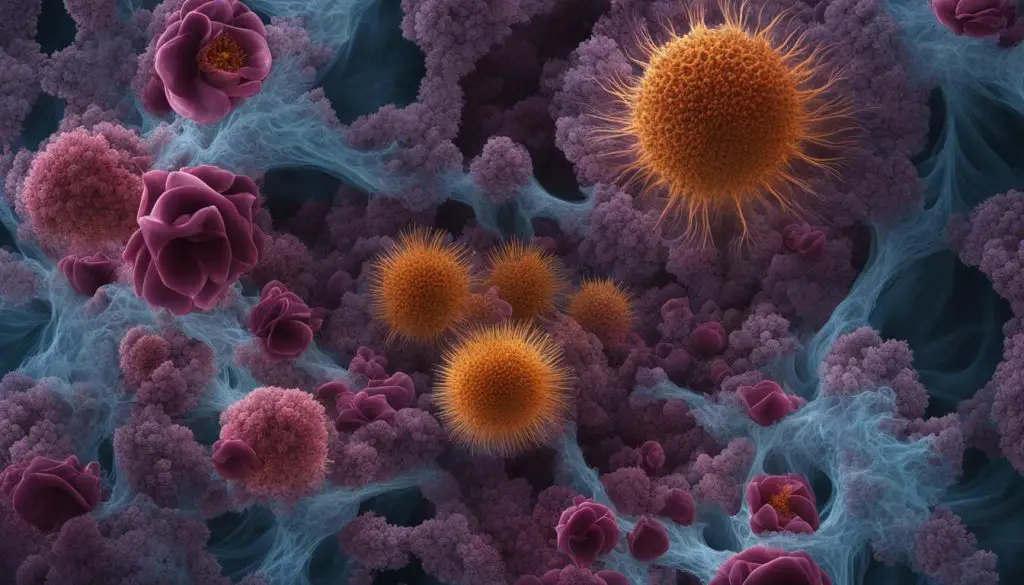Ad Blocker Detected
Our website is made possible by displaying online advertisements to our visitors. Please consider supporting us by disabling your ad blocker.
Welcome to our informative article on the relationship between testosterone and male fertility. As healthcare professionals, we recognize the importance of understanding the impact of testosterone therapy on spermatogenesis and fertility in men. It is crucial to educate patients, especially those of reproductive age, about the potential risks associated with exogenous testosterone.
Studies have indicated that exogenous testosterone can negatively affect sperm production by suppressing intratesticular testosterone levels, which are vital for normal spermatogenesis. This means that testosterone therapy can hinder fertility in men.
In this article, we will explore the extent of the issue, delve into the mechanism through which testosterone inhibits spermatogenesis, discuss the recovery process after discontinuing testosterone therapy, and explore alternative therapeutic approaches to protect the testis while preserving fertility. We will also touch upon the use of testosterone as a male contraceptive and discuss the prognosis for men seeking to regain their reproductive potential.
Key Takeaways:
- Testosterone therapy can have a negative impact on spermatogenesis and fertility in men.
- It is important for healthcare professionals to educate patients about the potential risks of testosterone therapy on fertility, particularly for men of reproductive age.
- Alternative treatments such as clomiphene citrate or hCG therapy can help preserve spermatogenesis and maintain future fertility potential for hypogonadal men.
- The recovery of spermatogenesis after discontinuation of testosterone therapy varies among individuals, and the prognosis for fertility depends on various factors.
- Consult with your healthcare provider to discuss your fertility goals when considering testosterone therapy.
The Extent of the Problem
Symptomatic hypogonadism is a prevalent condition, affecting over 6.5 million men in the United States. It is characterized by low testosterone levels, which can have significant implications for fertility. As men age, the prevalence of hypogonadism increases, with approximately 39% of men over 45 years old having low serum testosterone levels.
This rise in hypogonadism cases is further compounded by the growing use of testosterone therapies. While these therapies may provide relief for symptomatic hypogonadism, it is crucial to educate men about the potential impact of exogenous testosterone on spermatogenesis and fertility. Many men desiring fatherhood may not be aware of the potential risks associated with testosterone therapy, particularly in relation to their reproductive health.
If you’re interested, our table below provides an overview of the prevalence rates of low testosterone levels and the impact on fertility in aging men.

| Age Group | Prevalence of Low Testosterone Levels |
|---|---|
| 45-54 | 34% |
| 55-64 | 48% |
| 65-74 | 61% |
| 75-84 | 70% |
The data clearly highlights the high prevalence of low testosterone levels in aging men and emphasizes the need for a comprehensive understanding of the potential impact on fertility. By raising awareness and promoting informed decision-making, we can ensure that men have the necessary information to make choices that align with their reproductive goals.
How Testosterone Inhibits Spermatogenesis and Fertility
Testosterone therapy exerts its inhibitory effects on spermatogenesis through various mechanisms, including the suppression of gonadotropin-releasing hormone (GnRH) and gonadotropin secretion. These actions result in reduced intratesticular testosterone levels, which are essential for normal sperm production.
The negative feedback mechanism plays a crucial role in this process. When exogenous testosterone is introduced into the body, it signals the hypothalamus and pituitary gland to decrease the production of GnRH and gonadotropins, such as luteinizing hormone (LH) and follicle-stimulating hormone (FSH).
This decrease in gonadotropin secretion leads to lower levels of testosterone within the testes, known as intratesticular testosterone. Research has shown that intratesticular testosterone levels below 20 ng/mL can result in azoospermia, the absence of sperm in the ejaculate.
The suppression of gonadotropin secretion and subsequent reduction in intratesticular testosterone levels disrupt the delicate balance required for normal spermatogenesis, ultimately leading to impaired fertility in men receiving testosterone therapy.
To better understand the impact of testosterone on spermatogenesis, let’s take a closer look at the negative feedback loop:
- Step 1: Exogenous testosterone is administered to the body.
- Step 2: Increased testosterone levels in the bloodstream signal the hypothalamus to decrease GnRH production.
- Step 3: Reduced GnRH levels result in decreased LH and FSH production by the pituitary gland.
- Step 4: Lower levels of LH and FSH lead to decreased intratesticular testosterone levels, negatively impacting spermatogenesis.
- Step 5: Impaired spermatogenesis can result in reduced sperm production or azoospermia, affecting fertility.
It is important to note that this negative feedback loop is essential for maintaining the body’s homeostasis and regulating testosterone levels. However, in the context of exogenous testosterone therapy, the negative feedback loop can disrupt the delicate balance necessary for normal spermatogenesis and fertility.

Spermatogenesis Recovery after Discontinuation of Exogenous Testosterone
When men discontinue exogenous testosterone therapy, studies have shown that there is a high likelihood of recovering normal sperm production within one year. This encouraging finding suggests that the cessation of testosterone therapy can lead to a return of spermatogenesis, allowing men to regain their fertility potential.
It is important to note that the rate of recovery may vary among individuals. While most men can expect to see a recovery of spermatogenesis within one year, it is not guaranteed that all men will achieve their previous baseline sperm density. Factors such as the route of testosterone administration and the use of additional therapies, like human chorionic gonadotropin (hCG), may impact the time it takes for spermatogenesis to fully recover.
For a visual representation of the recovery of spermatogenesis after discontinuation of exogenous testosterone therapy, refer to the table below.
| Time Since Cessation of Testosterone Therapy | Recovery of Spermatogenesis |
|---|---|
| 6 months | Partial recovery |
| 1 year | Majority of men achieve normal sperm production |
| 1-2 years | Continued improvement in sperm parameters |
| 2+ years | Individual outcomes may vary |

As shown in the table, most men can expect a return of normal sperm production within one year after discontinuing testosterone therapy. However, it is important to keep in mind that individual outcomes may vary. It is recommended that men consult with their healthcare providers to discuss their specific circumstances and expectations regarding the recovery of spermatogenesis.
Testosterone as Male Contraceptive
Testosterone has been studied as a male contraceptive due to its ability to suppress spermatogenesis.
Research has shown that exogenous testosterone can effectively inhibit the production of sperm, making it an attractive option for contraception in theory.
In a study conducted by Smith et al., testosterone administration led to a significant suppression of spermatogenesis, with reduced sperm count observed in all participants.
However, it’s important to note that the use of testosterone as a contraceptive may not directly translate to hypogonadal men.
Studies on male contraception primarily focus on healthy men and their ability to recover spermatogenesis after discontinuation of testosterone therapy.
These findings may not fully reflect the recovery rates for hypogonadal men who desire to maintain their reproductive potential.
To illustrate this point, here is a table summarizing the impact of testosterone as a contraceptive on spermatogenesis and fertility:
| Effect | Impact |
|---|---|
| Suppression of Spermatogenesis | Testosterone significantly inhibits sperm production, leading to reduced fertility. |
| Recovery of Spermatogenesis | Spermatogenesis can recover after discontinuation of exogenous testosterone, but recovery rates may vary among individuals. |
| Impact on Fertility | While testosterone can be effective as a contraceptive method, its impact on fertility in hypogonadal men may differ from those with normal testosterone levels. |

These findings highlight the complexity of using testosterone as a contraceptive method and the need for further research to understand its implications for different populations.
For hypogonadal men concerned about preserving their fertility, it is advisable to consult with a healthcare professional to explore alternative contraceptive options that consider their specific circumstances.
Therapeutic Approaches to Protect the Testis
In order to minimize the potential negative effects of testosterone therapy on testicular health and fertility, several therapeutic approaches can be considered. These include:
1. Human Chorionic Gonadotropin (hCG) Therapy
hCG therapy is a treatment option that helps maintain testosterone production and supports testicular health during exogenous testosterone therapy. By mimicking the action of luteinizing hormone (LH), hCG stimulates the Leydig cells in the testes to produce testosterone. This helps mitigate the suppression of natural testosterone production and aids in preserving spermatogenesis.
2. Selective Estrogen Receptor Modulators (SERMs)
SERMs, such as clomiphene citrate, have demonstrated efficacy in protecting the testis during testosterone therapy. They work by inhibiting estrogen’s negative feedback on the hypothalamus and pituitary gland, leading to increased production of gonadotropins, including LH. This, in turn, promotes the release of endogenous testosterone and helps to maintain testicular function.
3. Aromatase Inhibitors
Although aromatase inhibitors are commonly used to decrease estrogen levels in certain conditions, they are not recommended for protecting the testis during testosterone therapy. Due to limited long-term data, the effects of aromatase inhibitors on testicular health and fertility remain uncertain. Therefore, their use in this context should be approached with caution.
These therapeutic approaches can be utilized alongside exogenous testosterone to support testicular function and preserve reproductive potential. The most suitable option will depend on individual circumstances and should be discussed with a healthcare professional.
| Therapy | Mechanism of Action | Benefits | Limitations |
|---|---|---|---|
| Human Chorionic Gonadotropin (hCG) Therapy | Stimulates Leydig cells to produce testosterone | Preserves spermatogenesis Minimizes testicular atrophy |
Potential injection site reactions Cost of therapy |
| Selective Estrogen Receptor Modulators (SERMs) | Inhibits estrogen’s negative feedback on LH production | Increases endogenous testosterone levels Preserves testicular function |
Potential side effects (e.g., hot flashes, mood swings) May not be effective for all individuals |
| Aromatase Inhibitors | Inhibits the conversion of testosterone to estrogen | Reduces estrogen levels in certain conditions | Limited long-term data Uncertain effects on testicular health |
Recovery Time and Prognosis
The recovery of spermatogenesis after discontinuation of exogenous testosterone therapy varies among individuals. While most men achieve a return of normal sperm production within one year, it is important to note that individual outcomes may vary. The prognosis for fertility depends on factors such as the duration of testosterone therapy, the age of the individual, and any underlying fertility issues.
Clomiphene Citrate as an Alternative Therapy
Clomiphene citrate is a highly effective and well-tolerated therapy for addressing symptomatic hypogonadism while preserving endogenous testosterone production and fertility. This oral therapy targets the hypothalamic-pituitary-gonadal axis to stimulate the natural production of testosterone.
“Clomiphene citrate has been shown to significantly increase endogenous testosterone levels, making it a valuable alternative to exogenous testosterone supplementation.”
Unlike exogenous testosterone therapy, which can suppress endogenous testosterone production and interfere with fertility, clomiphene citrate helps maintain the delicate balance of hormones necessary for spermatogenesis and the maintenance of fertility.
Through its action on the hypothalamus, clomiphene citrate stimulates the release of gonadotropin-releasing hormone (GnRH) and subsequently promotes the secretion of luteinizing hormone (LH) and follicle-stimulating hormone (FSH). These hormones play a crucial role in the production of testosterone and the development and maturation of sperm cells.
Clomiphene citrate offers a non-invasive and convenient oral therapy option for individuals with symptomatic hypogonadism who wish to preserve their fertility. This alternative therapy allows for the maintenance of adequate testosterone levels while supporting the natural process of spermatogenesis.
Various studies have shown the efficacy of clomiphene citrate in increasing endogenous testosterone levels, with a favorable safety profile and minimal side effects. This makes it an attractive option for individuals seeking a solution that addresses both their testosterone deficiency and their desire to maintain reproductive potential.
By harnessing the power of clomiphene citrate, healthcare professionals can provide patients with an alternative therapy that combines the benefits of testosterone production and the preservation of fertility.
Benefits of Clomiphene Citrate as an Alternative Therapy:
- Stimulates endogenous testosterone production
- Preserves fertility
- Convenient oral therapy
- Minimal side effects
- Non-invasive alternative to exogenous testosterone supplementation
| Benefit | Description |
|---|---|
| Stimulates Endogenous Testosterone Production | Clomiphene citrate acts on the hypothalamus to increase the release of GnRH, which in turn stimulates the production of LH and FSH. This promotes the natural synthesis of testosterone. |
| Preserves Fertility | By maintaining endogenous testosterone production, clomiphene citrate helps preserve the delicate hormonal balance necessary for spermatogenesis and fertility. |
| Convenient Oral Therapy | Clomiphene citrate is available in an oral form, making it a convenient and user-friendly therapy option for individuals with symptomatic hypogonadism. |
| Minimal Side Effects | Studies have demonstrated the favorable safety profile of clomiphene citrate, with minimal side effects reported in patients undergoing this alternative therapy. |
| Non-Invasive Alternative to Exogenous Testosterone Supplementation | Clomiphene citrate provides a non-invasive and hormone-regulating treatment option, avoiding the need for exogenous testosterone administration and its potential impact on fertility. |
Human Chorionic Gonadotropin (hCG) as an Alternative Therapy
For men who do not want to discontinue testosterone therapy, hCG therapy may be considered. hCG acts similarly to LH and stimulates testosterone production, helping to preserve spermatogenesis. This therapy can be used in combination with exogenous testosterone to maintain fertility potential.
Benefits of hCG Therapy:
hCG therapy offers several benefits as an alternative treatment for individuals undergoing testosterone supplementation:
- Preserves Spermatogenesis: By mimicking the effects of luteinizing hormone (LH), hCG therapy stimulates testosterone production in the testes, which helps maintain the process of spermatogenesis.
- Fertility Maintenance: Using hCG therapy alongside exogenous testosterone can help preserve fertility potential, allowing men to continue testosterone supplementation while minimizing the negative impact on reproductive health.
Adjuvant Therapies:
In some cases, combining hCG therapy with other treatments can optimize outcomes and improve overall results:
- Clomiphene Citrate: The combination of hCG therapy with clomiphene citrate, an oral therapy that stimulates the hypothalamic-pituitary-gonadal axis, may enhance the preservation of spermatogenesis and overall fertility.
“hCG therapy acts as a valuable alternative treatment for men undergoing testosterone supplementation, allowing them to maintain spermatogenesis and fertility potential. It can be used in conjunction with other therapies to further enhance outcomes.”
| Treatment Approach | Benefits |
|---|---|
| hCG Therapy | – Stimulates testosterone production – Preserves spermatogenesis – Maintains fertility potential |
| Clomiphene Citrate + hCG Therapy | – Synergistic effect in preserving spermatogenesis and fertility potential |
Conclusion
Testosterone therapy can have a significant impact on spermatogenesis and fertility in men. It is crucial for healthcare professionals to educate patients about the potential risks of exogenous testosterone on fertility, especially for men of reproductive age.
However, alternatives such as clomiphene citrate or hCG therapy can help preserve spermatogenesis and maintain future fertility potential for hypogonadal men. These alternative treatments target the hormonal balance and stimulate endogenous testosterone production to support both testosterone therapy and reproductive health.
Ultimately, individual prognosis may vary, and it is important for men to have open and honest discussions about their fertility goals with their healthcare providers when considering testosterone therapy. By exploring alternative treatments, men can take proactive steps to preserve their reproductive potential while managing their hormone levels effectively.
FAQ
How does testosterone therapy affect male fertility?
Testosterone therapy can negatively impact male fertility by suppressing intratesticular testosterone production, which is necessary for normal sperm production. Exogenous testosterone inhibits spermatogenesis by suppressing gonadotropin-releasing hormone (GnRH) and gonadotropin secretion, resulting in decreased intratesticular testosterone levels.
How prevalent is low testosterone and its impact on fertility?
Over 6.5 million men in the US are affected by symptomatic hypogonadism. Approximately 39% of men over 45 years old have low serum testosterone levels. Many men may not be aware of the potential impact of exogenous testosterone on spermatogenesis and fertility when considering testosterone therapy.
Does testosterone therapy lead to azoospermia?
Yes, low intratesticular testosterone levels below 20 ng/mL can result in azoospermia, which is the absence of sperm in the ejaculate. Exogenous testosterone therapy suppresses spermatogenesis, inhibiting the production of viable sperm.
Can spermatogenesis recover after discontinuing testosterone therapy?
Studies have shown that most men who discontinue exogenous testosterone therapy experience a return of normal sperm production within one year. The time to recovery may vary, and it is not guaranteed that all men will achieve their baseline sperm density.
Is testosterone used as a male contraceptive?
Testosterone has been studied as a male contraceptive due to its ability to suppress spermatogenesis. However, the use of testosterone as a contraceptive may not have the same effect on hypogonadal men. Recovery of spermatogenesis after discontinuation of exogenous testosterone may not fully reflect the recovery rates for men seeking to maintain their reproductive potential.
Are there therapies available to protect the testis during testosterone therapy?
Yes, therapies like human chorionic gonadotropin (hCG) therapy or selective estrogen receptor modulators (SERMs) such as clomiphene citrate can be used to help maintain testosterone production and preserve spermatogenesis. Aromatase inhibitors are not recommended due to limited long-term data.
How long does it take for spermatogenesis to recover after testosterone therapy?
While most men achieve a return of normal sperm production within one year after discontinuing exogenous testosterone therapy, individual recovery time may vary. The duration of testosterone therapy, age, and underlying fertility issues can affect the prognosis for fertility.
What is clomiphene citrate, and how does it help with fertility?
Clomiphene citrate is an effective and well-tolerated therapy for maintaining testosterone production and fertility. It increases endogenous testosterone production by targeting the hypothalamic-pituitary-gonadal axis. This oral therapy can help address symptomatic hypogonadism while preserving future fertility.
Can hCG therapy be used as an alternative therapy for preserving fertility?
Yes, hCG therapy can be considered for men who do not want to discontinue testosterone therapy. hCG acts similarly to luteinizing hormone (LH) and stimulates testosterone production, helping to preserve spermatogenesis. This therapy can be used in combination with exogenous testosterone to maintain fertility potential.
What should men consider when thinking about testosterone therapy and fertility?
It is crucial for men to discuss their fertility goals with their healthcare provider when considering testosterone therapy. Individual prognosis may vary, and alternative treatments like clomiphene citrate or hCG therapy can help preserve spermatogenesis and maintain future fertility potential.
How Does Testosterone Levels Impact Male Fertility?
Testosterone plays a crucial role in male physiology, including sperm production and fertility. Low levels of testosterone can lead to reduced sperm count and quality, making it more difficult for men to conceive. It’s important for men to maintain healthy testosterone levels for optimal reproductive health.


